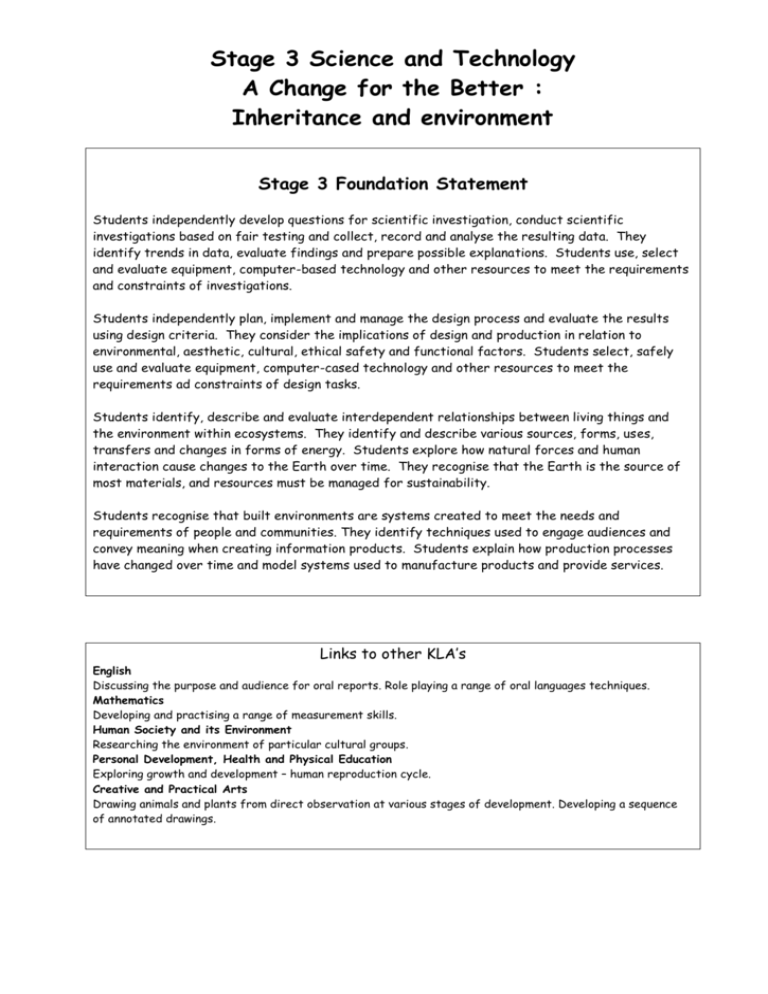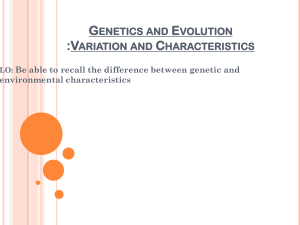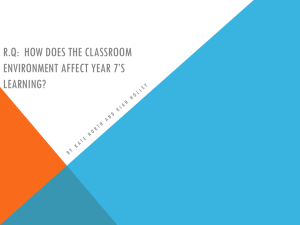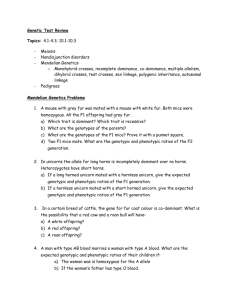Stage 3 Science and Technology: A Change for the Better
advertisement

Stage 3 Science and Technology A Change for the Better : Inheritance and environment Stage 3 Foundation Statement Students independently develop questions for scientific investigation, conduct scientific investigations based on fair testing and collect, record and analyse the resulting data. They identify trends in data, evaluate findings and prepare possible explanations. Students use, select and evaluate equipment, computer-based technology and other resources to meet the requirements and constraints of investigations. Students independently plan, implement and manage the design process and evaluate the results using design criteria. They consider the implications of design and production in relation to environmental, aesthetic, cultural, ethical safety and functional factors. Students select, safely use and evaluate equipment, computer-cased technology and other resources to meet the requirements ad constraints of design tasks. Students identify, describe and evaluate interdependent relationships between living things and the environment within ecosystems. They identify and describe various sources, forms, uses, transfers and changes in forms of energy. Students explore how natural forces and human interaction cause changes to the Earth over time. They recognise that the Earth is the source of most materials, and resources must be managed for sustainability. Students recognise that built environments are systems created to meet the needs and requirements of people and communities. They identify techniques used to engage audiences and convey meaning when creating information products. Students explain how production processes have changed over time and model systems used to manufacture products and provide services. Links to other KLA’s English Discussing the purpose and audience for oral reports. Role playing a range of oral languages techniques. Mathematics Developing and practising a range of measurement skills. Human Society and its Environment Researching the environment of particular cultural groups. Personal Development, Health and Physical Education Exploring growth and development – human reproduction cycle. Creative and Practical Arts Drawing animals and plants from direct observation at various stages of development. Developing a sequence of annotated drawings. Outcomes – Learning Processes Investigating INV S3.7 Conducts their own investigations and makes judgments based on the results of observing, questioning, planning, predicting, testing, collecting, recording and analysing data, and drawing conclusions. Designing and Making DM S3.8 Develops and resolves a design task by planning, implementing, managing and evaluating design processes. Using Technology UT S3.9 Evaluates, selects and uses a range of equipment, computer-based technology, materials and other resources to meet the requirements and constraints of investigating and designing tasks. Outcomes and Indicators LT S3.3 : Identifies, describes and evaluates the interactions between living things and their effects on the environment. Indicators • Devises a presentation for younger students on the likely impact of removing one form of life from a food chain. • Devises and implements a means of comparing physical characteristics (eg eye colour) of a family over three generations and presents findings. • Predicts outcomes of seed growth tests, undertakes tests, documents findings and shares conclusions • Undertakes a detailed observation of an insect colony, develops questions and plans nondestructive tests to collect more data • Plans and manages the construction of a bush food/vegetable garden, identifying and resolving the need for funds and expert advice • Develops a detailed plan to conserve or improve a local nature reserve/park using a simple scale, symbols and annotations • Uses a water testing device to check the water pollution level in a local waterway and discusses findings, eg with an expert • Selects the most appropriate medium to record and investigate local plants used by an Aboriginal community • Prepares arguments about the potential effects of a new technology on living things after viewing a newsclip, eg the bionic ear. Resources Family Photos (Teachers) Excel, PowerPoint and computer programs. Assessment Eduweb Summative Evaluation Learning Experiences Week/ s Week 1 Weeks 2 –3 Learning Experiences Unit Introduction. What do we already know about Inheritance and Environment? Brainstorm using mind map, etc. Share a story, visual text, sites on the Internet based on the Unit to build up background knowledge. Encourage children to share what they already know about the unit with others. What are our Outcomes? What do we hope to learn by the conclusion of the Unit? Title Page. Exploring Inherited Characteristics in People. Share your own family photos with children building a small family tree as you go. Encourage children to discuss similarities / differences. Discuss with children what you are looking for in this lesson, eg “ The outcome of this lesson is for us to explore our own inherited characteristics”. Children create their own “family tree” highlighting significant inherited characteristics within their family. Children can sketch, write, record in any way they wish. Sharing circle – Children form groups to discuss Date Weeks 4-5 what they have found and what they have learned. As a class, design a spreadsheet of the areas that children display inherited characteristics, hair colour, eye colour, etc. Using PowerPoint, children write their own report based on their findings and present it to the class. Using the spreadsheet, generate a variety of different graphs depicting the results of the class. Discuss and display. Exploring Inherited Characteristics in Animals. Observe characteristics of animals that are passed on to each generation, eg skin/fur colour, size, features. Research how the characteristics of domestic animals have been changed by people, eg breeding beef cattle, merino sheep to maximise wool yields, breeding dogs and cats to meet particular criteria. Generalise about the passing on of information from parent to offspring. Predict outcomes of substitute parenting. Discuss what will grow if a tomato seed is planted. Why? What will hatch if a duck sits on a chicken’s egg? Why? Week 6 Revision and Catch Up Weeks 7-8 Investigate how species of plants and animals are suited to their environment. Plan an excursion or invite an Education Officer in from the Zoo or Wildlife Parks. Identify the specific characteristics of given animals, eg kangaroos have large back legs, eat grass etc, possums have long claws, large eyes, dark fur, are nocturnal. Include physical features, habits, food, behaviour. Research the characteristics of environments, eg desert, savannah, alpine, marine, jungle. Include vegetation, colours, landforms, climate, availability of water. Match animals to their native environment. Identify features that make them particularly suited to their environment, eg kangaroos’ fur colour blends with soil or vegetation colour, largely inactive in heat of day etc. Note similarities and differences Week 9 between species in a specific habitat. Suggest reasons for these. Research the relationship between species, eg food webs and chains, competing for similar food source etc. Case study a particular species. Prepare a report (PowerPoint, Eduweb) detailing how it fits into its environment and satisfies its needs. Visit a botanic garden to observe plants growing in a specific environment. Include a lesson with an education officer. Observe plants that are found in particular areas, eg arid, mangroves, rainforest, temperate. Identify characteristics common to each habitat, include leaf type and size, fruit, seed pods, flowers, plant size etc. Research how characteristics may aid the plant’s survival in that area. Make generalisations about plants from different habitats. Observe other examples and predict where the plants come from. Give reasons for predictions. Research to test predictions. Design a model to illustrate how animals are suited to a particular environment. Children have the choice of creating their models individually or in small groups. Include initial sketches, organisation of materials and tools, final construction and presentation. Using information gained through investigations identify the features and behaviours of selected animal(s). List physical characteristics of their environments to be included. Explore appropriate materials to be used for animal models and for background setting. Consider how well they can be moulded, coloured/decorated etc. Consider how the model may be made to demonstrate the relationship between the animals and their environment, eg animals moving from one area to another to demonstrate camouflage. Present findings to class. Week 10 Revision Reflect on the mind map, etc from Week 1 and now in another colour add what else the class has learnt on this topic. Evaluate unit and allow time for children to reflect over their work and to summarise in their own words what their greatest think they learnt during the unit.








